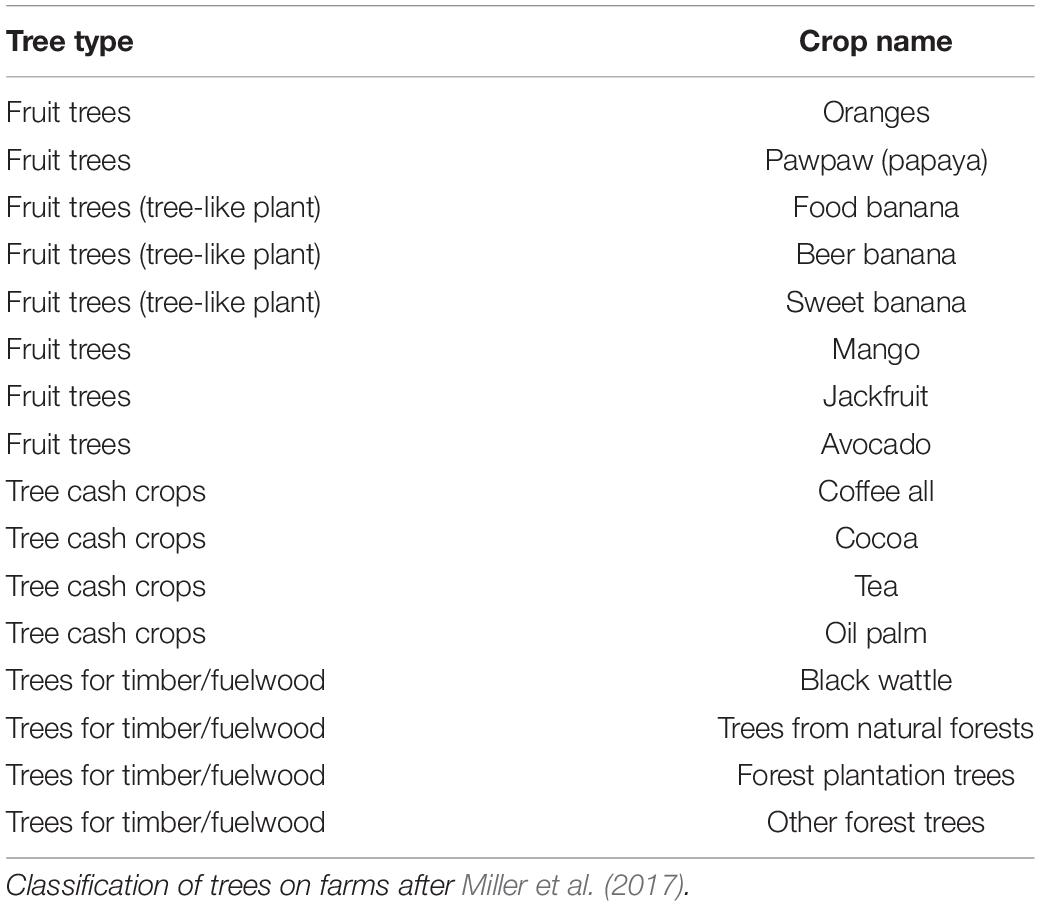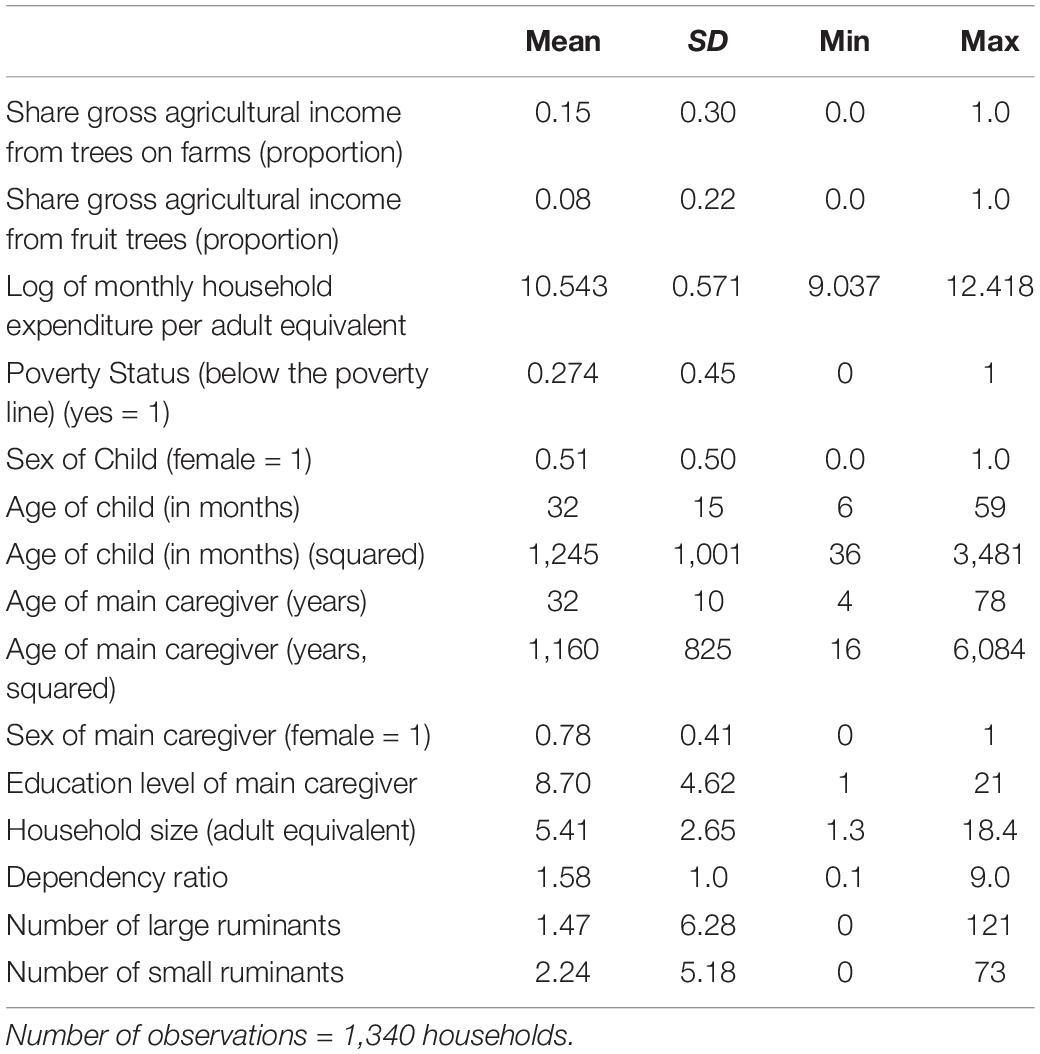Do Trees on Farms Improve Household Well-Being? Evidence From National Panel Data in Uganda
- 1Department of Natural Resources and Environmental Sciences, University of Illinois, Urbana, IL, United States
- 2Department of Economics, Universidad EAFIT, Medellín, Colombia
- 3Department of Geosciences and Natural Resource Management, University of Copenhagen, Copenhagen, Denmark
- 4Development Data Group, World Bank, Rome, Italy
Trees on farms provide livelihood benefits to households across Africa. To date, however, evidence on how such trees affect household well-being over time remains lacking. Evidence is especially sparse at the national level where it has particular value for policymaking. To address this knowledge gap, we use nationally representative panel data from Uganda to examine how on-farm tree growing may affect two dimensions of household well-being: 1) income and 2) food security and nutrition. We analyzed household-level data from the 2005–2006, 2010–2011, and 2013–2014 Ugandan National Panel Surveys, including measures on adoption and abandonment of trees on farms, demographic factors, and other socioeconomic variables. We used a fixed-effects panel specification and probabilistic models to assess the relationship between the area devoted to trees on farms and household income and nutrition outcomes for 1,395 households across Uganda. Our results show that growing trees especially fruit trees, was associated with improvements in both total household consumption and nutritional outcomes (proxied by weight and wasting status of children younger than 5 years old). These findings suggest the important role trees on farms can play in poverty reduction and sustainable development efforts in Uganda and other countries in Africa and beyond.
Introduction
Trees on farms provide vital inputs to support the livelihoods of rural people across many low- and middle-income countries (LMICs). Whether as a source of timber or non-timber products or for environmental services such as nitrogen fixing, pollination, or prevention of soil erosion, trees can play an important role in rural household well-being (Garrity et al., 2010; Place et al., 2016; Reed et al., 2017; Waldron et al., 2017). However, the contribution that trees on farms make to many farmers’ livelihoods often goes unacknowledged in national reporting, reflecting a lack of official interest in so-called “Cinderella species” that provide rural households in LMICs with a multitude of everyday products (Leakey and Newton, 1994). Recognizing the welfare implications of having trees on farms is especially important given that trees have been found to reduce the exposure and sensitivity to external shocks such as those related to climate change and variability, food scarcity, market volatility, and financial liquidity constraints, among others (Mbow et al., 2014; Place et al., 2016). A number of case studies (e.g., Schreckenberg et al., 2006; Amadu et al., 2020) and country-scale studies (Miller et al., 2017) from Africa have demonstrated the contribution on-farm trees make to household income and food security.
Trees on Farms Contribution to Income and Consumption
Trees can enable economic gains through sale and consumption of timber and non-timber products, as well as the environmental services they provide (Angelsen et al., 2014; Reed et al., 2017). Trees on farms can provide similar services as those from nearby forests, but they also present benefit possibilities through the establishment and management of agroforestry (the integration of woody perennials into farming systems) and other productive systems. For example, some of the most popular commodity agricultural products, such as coffee and cacao, derive from trees. A recent cross-national study in Africa (Miller et al., 2017) estimated trees grown on farms with a productive function such as tree cash crops or fruit trees provided an average of 17% of total annual gross income for tree-growing households and 6% for all rural households.
Trees – in forests and on farms – can also contribute to livelihoods through provision of environmental services such as pollination, soil enrichment and stabilization, and water retention, among others. Evidence on these indirect effects of trees on agricultural production and household income in Africa is increasing, with, for example, recent quasi-experimental assessments identifying links between fertilizer trees and agricultural productivity (Coulibaly et al., 2017; Amadu et al., 2020; Hughes et al., 2020).
Despite the long time horizon from initial investment to realizing economic benefits, insecure property rights, and unfavorable public policies that farmers often face in different contexts in Africa, millions of rural households across the continent do plant and manage trees on their land (Zomer et al., 2016). The widely recognized interest of farmers in reducing risk helps explain why they choose to do so (Scott, 1976; Meijer et al., 2015). In particular, rural households in Africa may seek to diversify their livelihoods to mitigate and adapt to social and ecological shocks, as greater diversity in the assets available for income and consumption supports households that are more resilient to food insecurity (Angelsen et al., 2014; Lasco et al., 2014). Trees on farms present an important avenue for enhancing such economic diversity even as they also contribute to ecological diversity in farming systems (Bhagwat et al., 2008).
The consolidation of local and regional markets in LMICs has also boosted the marketability of many products gathered from trees. Rapid urbanization and population growth have markedly increased the demand for food products, which has offered opportunities to make agricultural production profitable for many rural households (Ferris et al., 2014). At the same time, tree products such as coffee and cacao may help provide relatively stable sources of income in the face of market and other crises (Bacon, 2005).
Trees on Farms Contribution to Food Security and Nutrition
Trees provide fruits, leafy vegetables, nuts, seeds, and edible oils than can help households to diversify diets; provide key micronutrients; and increase caloric intake (Ickowitz et al., 2014; Vira et al., 2015). Trees can affect household nutrition through several different pathways, including by boosting the diversity of agricultural production (Baudron et al., 2017).
Many local-scale case studies exist on the relationship between the presence of trees and food production in Africa and other LMIC contexts (Miller et al., 2020). In a review of these studies, Reed et al. (2017) found that the majority of cases (52%) recorded a net positive effect of the presence of trees on food production. Among the different food products from trees, fruit stands out as the main source of dietary complementarity for many rural households. Globally, approximately 50% of all fruits consumed derive from trees, most of which come from cultivated sources (Vira et al., 2015). Fruit trees are often easy for households to domesticate and plant within their farms and provide an important path to cover key nutritional needs (Kareiva et al., 2007; Fulton et al., 2016; Willett et al., 2019). Fruits such as baobab, mango, papaya, and orange are high in vitamins which can help cover the basic daily requirements in micronutrients (Hall et al., 2009; Vira et al., 2015).
The role of “non-productive” trees in household well-being often remains overlooked in policy and research, yet domestication of wild trees can offer multiple services to support household production and well-being (Kareiva et al., 2007; Miller et al., 2017). The interactions among different kinds of trees, such as tree cash crops and fruit trees, or trees and agricultural production within agroforestry systems, are also potentially important for enhancing food security and nutrition. For example, fruit-bearing trees are often grown in coffee plantations in Ethiopia as shade to improve productivity for coffee but also to provide an additional food source, as well as firewood and timber (Muleta et al., 2011). Trees on farms can also boost livestock production by providing fodder for animals, which then provide meat, milk, and eggs, as well as manure to improve agricultural production and crop nutritional quality (Franzel et al., 2014; Gergel et al., 2020).
Knowledge Gaps on Linkages Between Trees on Farms and Household Well-Being
As with a related literature on forest livelihoods (Angelsen et al., 2014; Cheng et al., 2019; Miller and Hajjar, 2020), most available quantitative evidence on the household well-being effects of on-farm trees relies on cross-sectional data (Miller et al., 2020). Of those studies that do include a temporal dimension, few examine change over a long-time period. For example, only 9% (7 of 74) of the studies reviewed by Reed et al. (2017) covered a period 10 years or longer.
The paucity of studies using time series and panel data poses a major constraint on understanding how trees on farms affect household well-being. Existing evidence focuses on the relationship between tree cover and livelihood outcomes, but knowledge of how change in the species grown, their spatial arrangement, and other dimensions of on-farm tree management affects livelihoods remains limited. Further, taking a longer-term view is especially important in the case of trees given that they often take considerable time to grow and yield benefits.
There is also a dearth of information on the socioeconomic impacts of trees on farms at the national scale, where such evidence has particular relevance for policy. In the absence of knowledge on the welfare effects of on-farm tree management, trees risk being overlooked in key policy processes, thereby undermining their potential role in achieving several of the UN Sustainable Development Goals (Waldron et al., 2017).
In this article, we address these gaps in the literature through a national-scale case study in Uganda examining the relationship between trees on farms and household well-being over the long term. We focus on two ways trees might affect household well-being: (i) as a source of income and consumption and (ii) as providing nutritionally important foods, such as fruits. We expect that increasing the area allocated to trees on farms will be associated with positive outcomes on both of these dimensions of human well-being. On the one hand, on-farm tree management may improve agricultural production through diversification as well as increasing yields, which can in turn boost income. Production obtained from trees on farms may form a relatively reliable source of income as households can benefit from the timber and non-timber products as well as the environmental services that trees deliver even in times of seasonal and climatic stress (Lasco et al., 2014; Reed et al., 2017; Miller et al., 2017). On the other hand, trees also provide food products (e.g., fruits, leafy vegetables, nuts, seeds, and edible oils, among others) that can help households to diversify diets and increase caloric intake (Ickowitz et al., 2014; Vira et al., 2015; Reed et al., 2017).
This study uses data from the 2005–2006, 2010-2011, and 2013–2014 Ugandan National Panel Survey (UNPS) to assess changes in livelihood outcomes and link these changes to trees on farms. Specifically, we examine the relationship between the proportion of farm plot area allocated to trees and (i) changes in total household consumption (including food and non-food products, such as housing materials, funeral and marriage costs, etc.) using a fixed-effects panel specification and (ii) the proportion of gross agricultural household income derived from trees on farms and the nutritional status of children younger than 5 years (proxied by child stunting, wasting, or being underweight) using a probabilistic model.
Results support both of our hypotheses, with evidence suggesting that improvements in both total consumption patterns and nutritional outcomes are associated with having more on-farm trees. These findings show that the adoption of trees on farms can play a significant role in long-term consumption dynamics, which can help build overall household resilience (Dewees, 2013; Barrett and Constas, 2014). In the short term, our findings also show how trees on farms can contribute to better nutritional outcomes for children younger than 5 years.
Materials and Methods
Survey Data
This study centers on data from the UNPS implemented by the Uganda Bureau of Statistics available over five waves in 2005–2006, 2009–2010, 2010–2011, 2011–2012, and 2013–2014. These surveys follow a similar design, collecting information on a range of socioeconomic and demographic characteristics of each study household, including extensive information on crops and other agriculture-related activities. Importantly, they are designed to be nationally representative, based on a stratified random sample of the Ugandan population.
A significant empirical challenge of studying the relationship between trees on farms and household livelihoods is the long-term nature of adopting, growing, and managing trees. The time gap between sowing and production means that most cross-sectional as well as short-duration longitudinal studies are unable to capture the dynamics of trees within rural household decision making. The relatively long time period over which UNPS data were collected provides an opportunity to address this issue at a national scale. We therefore used data from the earliest (2005–2006) and most recent (at the time of writing, 2013–2014) waves. This nearly decade-long interval presents the opportunity to detect and analyze the relationship in changes in on-farm tree growing and management and changes in household well-being. To increase variation in our panel, we also used data from a middle wave (2020–2011) in the consumption analysis.
The 2013–2014 UNPS collected information from 3,119 households in 322 enumeration areas (EAs), selected out of the 783 EAs that had been visited by the UNPS in 2005/2006. The 2013–2014 sampling strategy included 72 EAs (58 rural and 14 urban) in each of the (i) Central Region (with the exception of Kampala District, which was sampled separately), (ii) Eastern Region, (iii) Western Region, and (iv) Northern Region. Of this sample, 1,568 were households originally interviewed during 2005/2006 and 2010/2011, 265 were households formed by former members of original households, and 1,286 were new households. Our analysis focuses on those rural households for which information for 2005/2006, 2010/2011, and 2013/2014 was available, a total of 1,395 households. These households are located throughout Ugandan national territory (Figure 1).
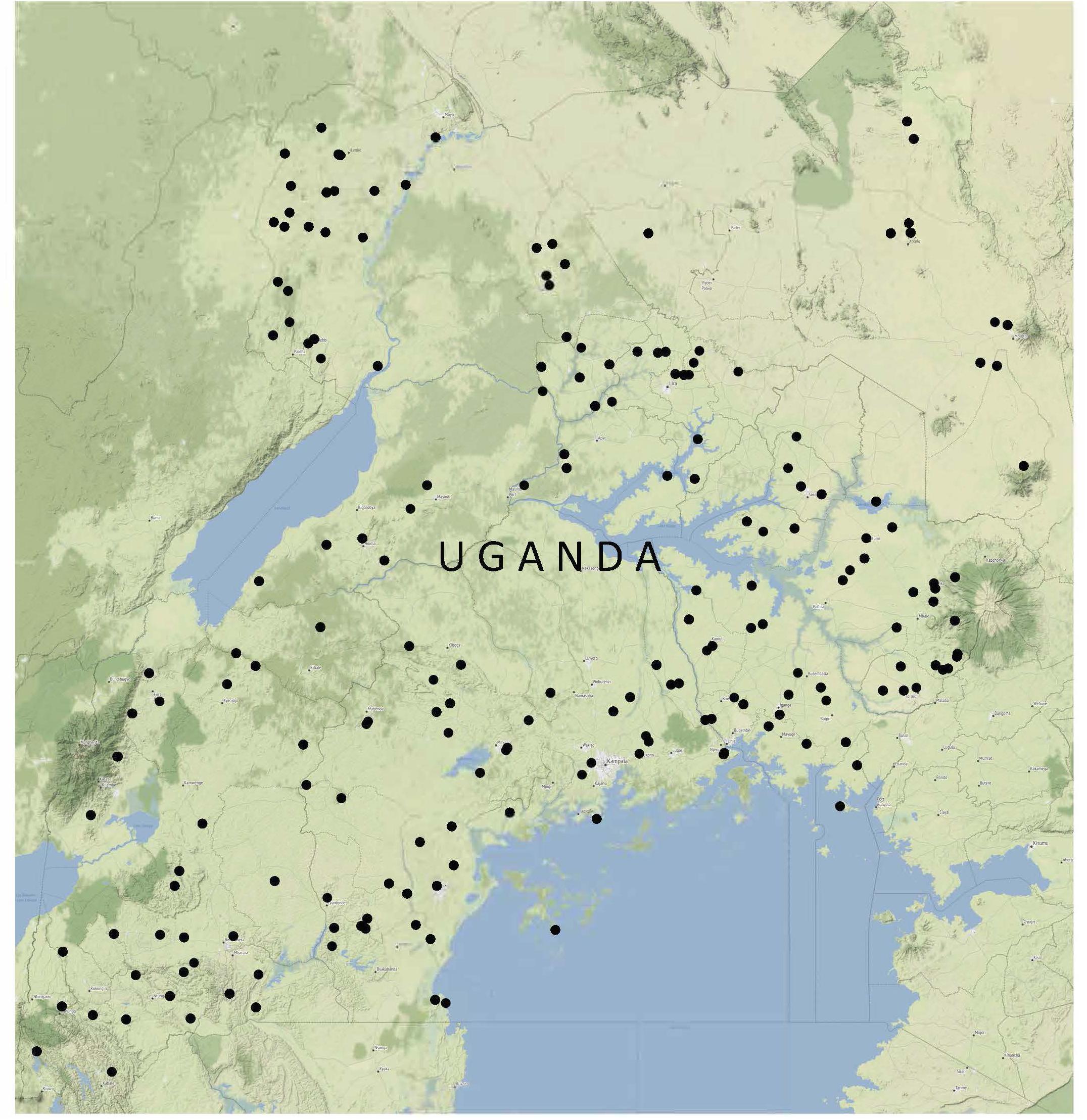
Figure 1. Spatial distribution of study households across Uganda. This figure shows the public coordinates of household clusters used in our sample of 1,395 rural households in Uganda (to protect confidentiality, household location coordinates in the data are not exact, but rather based on a random distortion of 0–5 km). Data source: UNPS 2005–2006, 2010-2011, and 2013–2014.
Identifying Trees on Farms
A specific (agro)forestry module was not available for use in the UNPS, which posed an initial methodological challenge in identifying the stock of trees on farms.1 We followed the approach developed by Miller et al. (2017) to measure the presence and stock of trees on farms using information on crops planted and other land use from the survey data. That study offered a validated crop list where each crop was classified according to its biological description as being or not being a tree. To qualify as a tree, the plant should be a woody perennial with an elongated stem, or trunk, which supports branches and leaves. All such plants on cultivated plots were included in the analysis for this article. For uncultivated plots, those that were covered by forest or other unproductive uses that involved presence of trees were also included. We were able to identify the stock of three types of trees using this approach: fruit trees, tree cash crops, and trees for timber and fuelwood. We note that this approach is as comprehensive as possible given available data but may still miss the presence of other types of on-farm trees such as those in home gardens, tree fences, and other trees deemed unproductive, among others (Miller et al., 2017).
Bananas present a special case in the context of Uganda. Biologically, a banana plant (genus Musa) is classified as a perennial herb. However, from a household economy point of view, they function like a tree in many ways. Banana plants can reach tree height within a year and yield fruit within 9 months, but this timing depends on biophysical conditions including soil quality, slope, and elevation, among others. They also provide shade. When the main stem dies, new stems are formed at the base of the plant, and so a commercial banana plant is essentially a system that can be productive up to 10 years (Arvanitoyannis and Mavromatis, 2009). In addition to these tree-like characteristics, we also include bananas as their production is widespread across Uganda, especially in the so-called banana-coffee arc near Lake Victoria (Hulme et al., 2013). Finally, we note that bananas have been included in other studies of the socioeconomic contributions of trees, including a global assessment of forest, trees, and food security and nutrition (Vira et al., 2015). Given these considerations, we include bananas as fruit trees in a complementary analysis.
Table 1 presents the crop classification defining trees on farms we constructed based on UNPS data. We note that, as for much of East and Central Africa, three types of banana plants are common in Uganda: (1) food bananas, which are often called African Highland bananas and are largely produced for home consumption with surplus sold to the market; (2) beer bananas, which are used to make banana beer for consumption within the household or to generate income through sale to consumers; and (3) sweet or dessert bananas (Swennen and Vuylsteke, 1991).
When including bananas in the fruit classification, the percentage of households with presence of trees on farms was approximately 53% in 2005–2006 and 49% in 2013–2014. The most common type of tree was fruit trees, including bananas, where 50% of the households reported presence of this type of tree. A similar proportion of households reported having cash crop trees in the first and last study periods (27% in 2005–2006 and 26% in 2013–2014). Figure 2 shows the decomposition of each category by type of crop (For this and the remaining figures, we focus on the first and last study periods as these are common to both of our analyses and show data from the longest time period). Food banana was the most common fruit with approximately 47% of households reporting having this plant in both periods, with coffee second (28% of households reported growing coffee in both waves). These percentages are somewhat higher than those in the study by Miller et al. (2017), which excluded bananas from analysis and reported 30% of landowners having trees on their farms for the 2010–2011 survey round in Uganda.
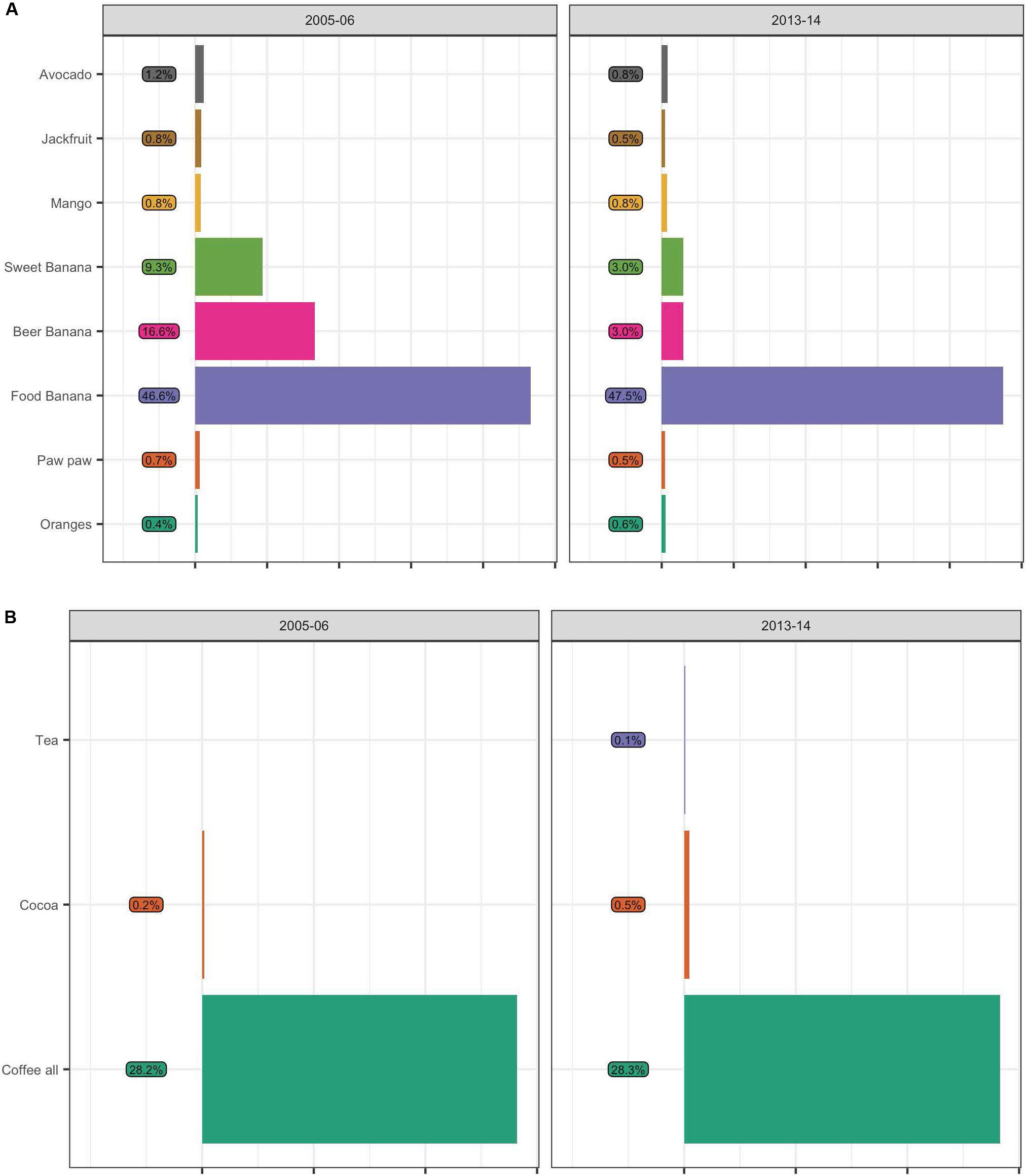
Figure 2. Percent of households reporting trees on farms, by survey wave and type of tree: (A) fruit trees and (B) tree cash crops. n = 1,395 rural households. Data source: UNPS 2005–2006 and 2013–2014.
Regarding the intensity of those households that have trees on farms, we found that between the two survey periods there was an increase in the share of plots allocated to trees. In 2005–2006, households with trees on farms had an average of 11% of their land allocated to trees, whereas in 2013–2014, this share increased to 13%. Figure 3 presents the distributions. The difference between these variables for the two periods was statistically significant (t-test = -2.864; p = 0.004).
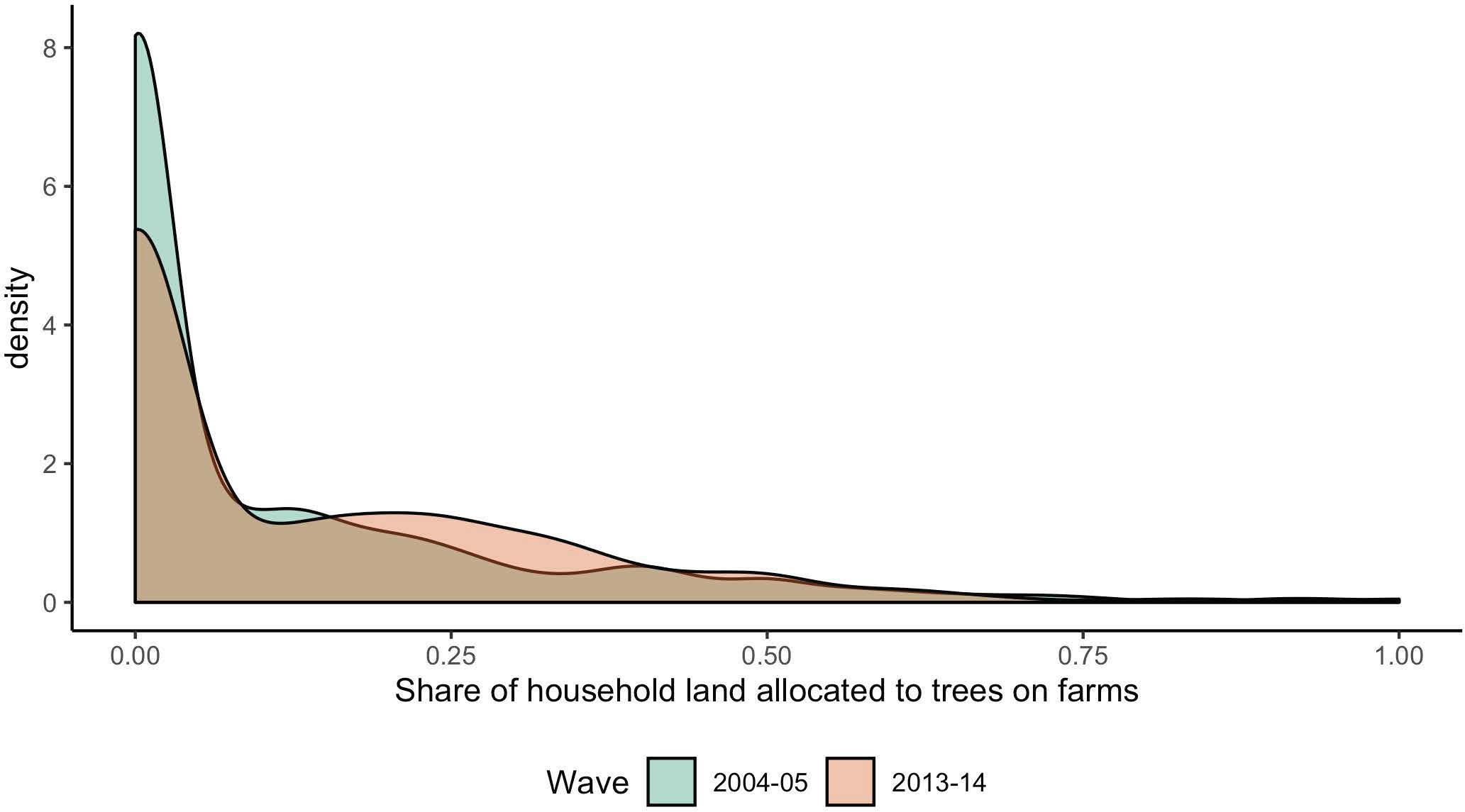
Figure 3. Allocation of land to trees on farms across survey waves. n = 1,395 rural households. Brown color shows overlap between two survey waves. Data source: UNPS 2005–2006 and 2013–2014.
Livelihoods Measures
UNPS surveys included detailed information on food and non-food household consumption, which build to an aggregation of total consumption per household. Figure 4 presents the distribution of the total monthly household consumption per adult equivalent in 2010 constant prices (natural logged), by changes in the presence of trees on farms. A first glance, Figure 4 shows that there is an overall increase in household consumption among the Ugandan households. In 2005–2006, an average household had a monthly total consumption per adult equivalent to 53,221 Ugandan Shillings (UGX$) (around $24 in constant 2010 US$), whereas in 2013–2014 it increased to 74,384 UGX$ (around $34 in constant 2010 US$). The increase was significantly higher for those households who either increased the area with trees on farms (monthly consumption per adult equivalent rising with 22,056 UGX$ or 10 in constant 2010 US$) or decreased the area (consumption increase of 24,300 UGX$ or 11 in constant 2010 US$) as compared to those who did not change the area or never had trees on farms (consumption increase of 16,030 UGX$ or 7 in constant 2010 US$) (Figure 4).
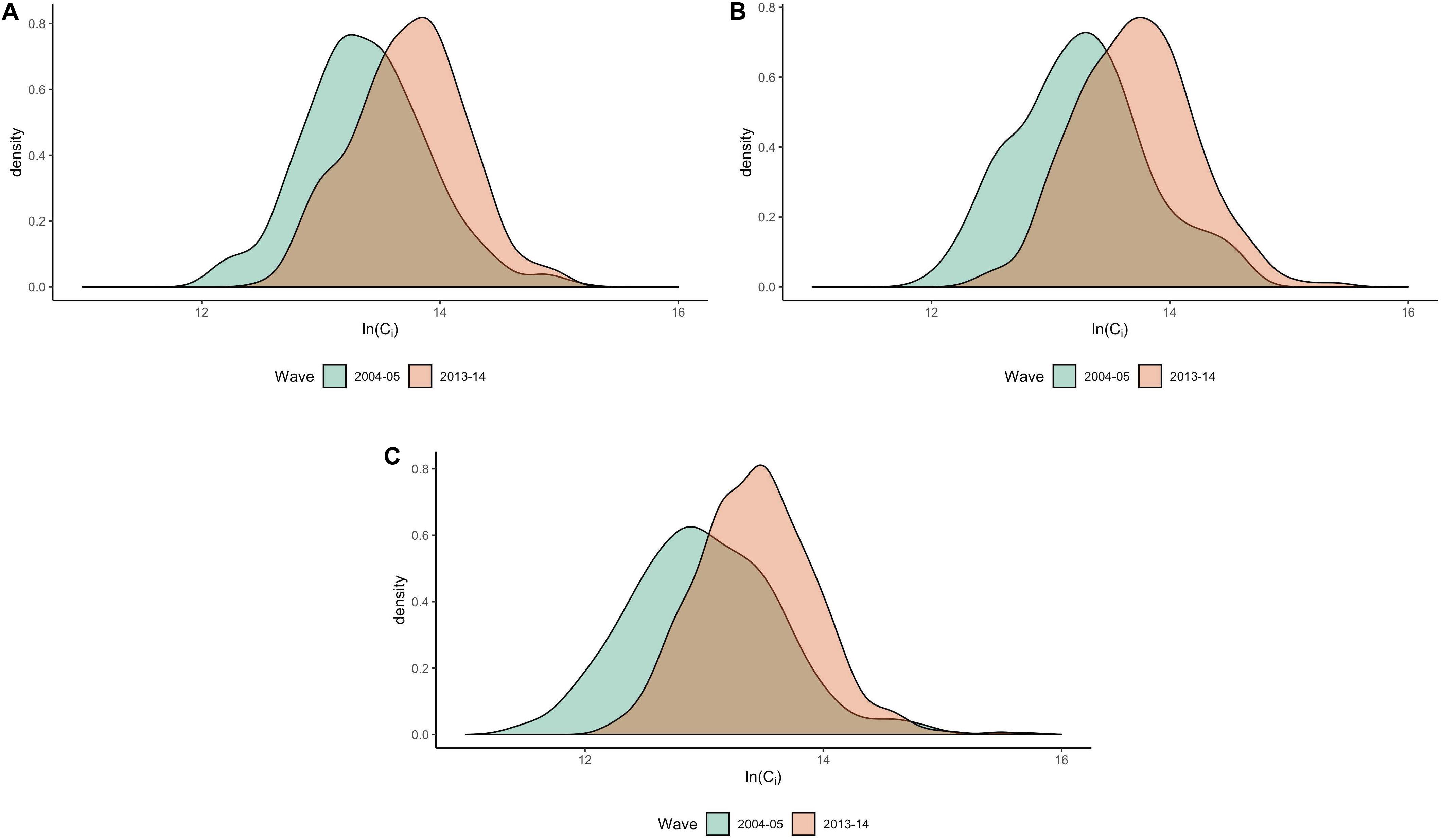
Figure 4. Distribution of the log total annual household consumption per adult equivalent [in constant 2010 prices; Ugandan shillings (UGX$)] for the 2005–2006 and 2013–2014 survey waves for (A) households who increased the share of area allocated to trees on farms, (B) households who decreased the share of area allocated to trees on farms, and (C) households who did not change the land allocated to trees on farms or did not have trees on farms. For (A): mean 2004–2005 = 60,307.84 UGX$; mean 2013–2014 = 82,364.55 UGX$; diff = 22,056.71; diff t-test = 9.3473***. For (B): mean 2004–2005 = 57,388.2 UGX$; mean 2013–2014 = 81,688.83 UGX$; diff = 24,300.59; diff t-test = 7.5104***. For (C): mean 2004–2005 = 46,135.97 UGX$; mean 2013–2014 = 62,166.61 UGX$; diff = 16,030.64; diff t-test = 6.2985***. n = 1,395 rural households. Brown color shows overlap between two survey waves. Data source: UNPS 2005–2006 and 2013–2014.
Table 2 presents descriptive statistics for the main household consumption variables (e.g., value of food consumption and consumption of durables) across the three survey waves.
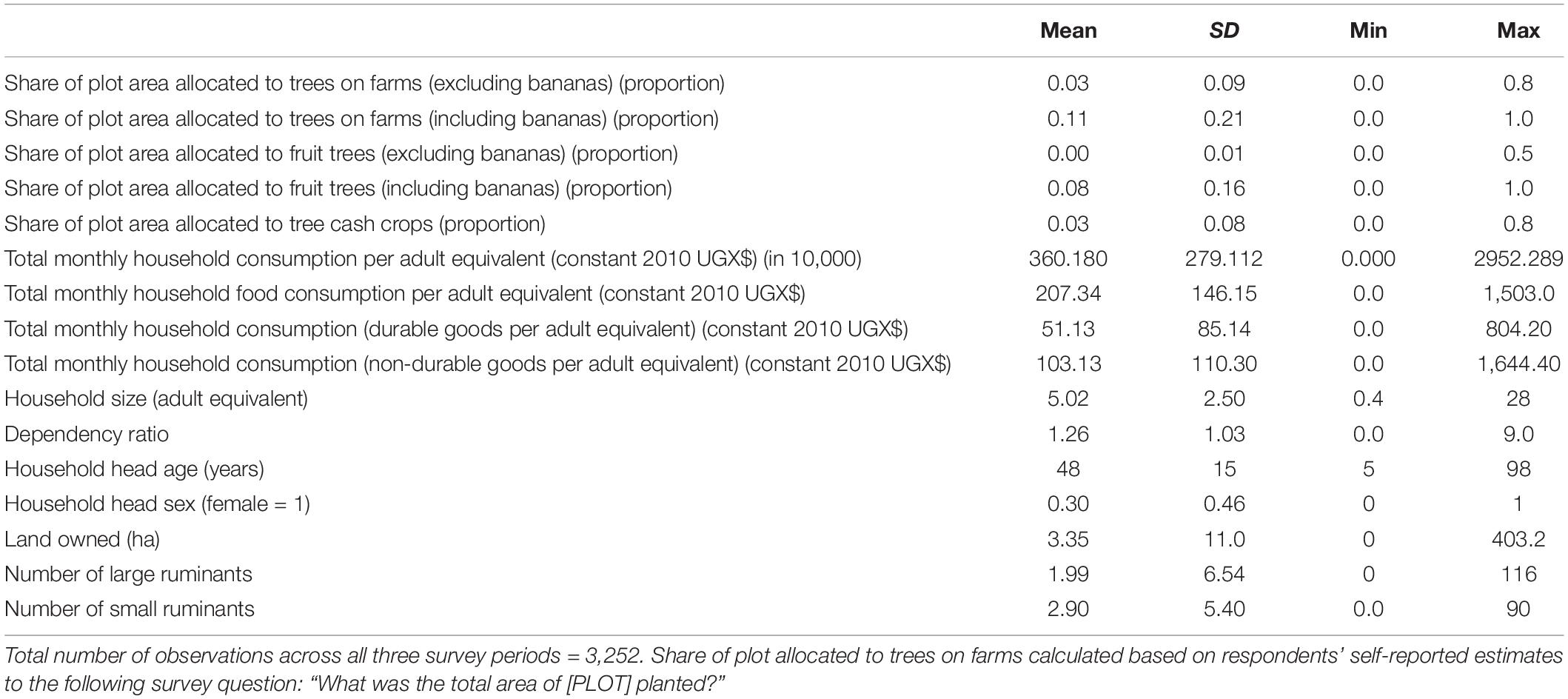
Table 2. Summary statistics for key variables in the panel data for three survey periods (UNPS 2005–2006, 2010–2011, and 2013–2014).
To provide additional insight into the role of trees on farms in household food security, we also use additional outcome variables considered proxies for nutritional status (World Health Organization and UNICEF, 2009). We employ indicators based on child growth standards provided by the World Health Organization using information on children younger than 5 years gathered in the 2013–2014 UNPS: height-for-age (HA), weight-for-age (WA), weight-for-height (WH) (World Health Organization and UNICEF, 2009). We estimate the z score and then classify each child as stunted, underweight, or wasted if her/his HA, WA, or WH z scores are below -2 standard deviations as per WHO standards (Table 3).
Regression Analysis
We used different empirical strategies to test our two main hypotheses about the association between trees on farms and household well-being. First, we estimated the relationship between trees on farms and household consumption outcomes. Second, we tested whether the share of gross agricultural income coming from trees on farms was associated with improved nutritional status for children younger than 5 years.
Trees on Farms and Changes in Household Consumption
To assess the relationship between the presence of trees on farms and consumption, we took advantage of the longitudinal structure of our data to cover three time periods: 2005–2006, 2010–2011, and 2013–2014. As mentioned previously, we hypothesize that an increase in the area allocated to trees on farms will smooth household consumption by increasing household income and by providing alternative and more diverse sources of food. We used a fixed-effects panel data specification as follows:
where lnCit is the total consumption per adult equivalent in the household i at time t. We estimated three consumption outcomes: (i) total consumption per adult equivalent, (ii) total food consumption per adult equivalent, and (iii) total consumption in durable goods per adult equivalent. The variable treesonfarmi,t is the share of farm area with presence of trees. αi is a household fixed effect that controls for time-invariant unobservables at the household level. Under this specification, we control for fixed household heterogeneity, which may affect the level of consumption in each survey round. Likewise, we included a set of dummy variables, wavei, to capture common time trends associated with each wave. We estimated this model with and without bananas to understand the role of bananas in household well-being.
Given the longitudinal nature of our data, we were able to control for a wide set of factors in each wave (Xit). First, we included a dummy variable indicating whether a given household changed their home between survey rounds as migration can significantly improve household consumption (Beegle et al., 2011). Second, we controlled for multiple household head characteristics, as well as assets, livestock, and land owned. Third, we included the baseline share of plot allocated to trees on farms. Finally, we included a set of fixed effects for stratum and agroecological areas to estimate the relation between trees on farms and change in consumption using the variation within the same natural conditions. Robust standard errors are clustered based on the sampling strategy.
Trees on Farms and Nutrition
We also explored the relationship between the presence of trees on farms and the nutritional status of children younger than 5 years collected during the 2013/2014 wave. To do so, we estimated a probabilistic model to examine how the presence of trees on farms related to the probability of a given child suffering from stunting, wasting, or being underweight. Through this model, we aimed to assess whether and how adopting trees on farms may relate to the odds of children younger than 5 years being malnourished. The model was written as:
where ϕ is the standard cumulative distribution function, and Xi is the set of controls. Thus, we estimated the marginal contribution of the different controls over the three main indicators of nutritional outcomes for children: stunted, wasted, or underweight.
Our controls comprised Xi = (treesonfarmi,indi, caregiveri,hhi). First, we included the share of the gross agricultural income based on trees on farms and, alternatively, on fruit trees (treesonfarmi). Second, we included a set of controls related to characteristics of children in a given household (indi) (i.e., age and gender). Third, we included socioeconomic characteristics (sex, age, and educational level) of the main caregiver (caregiveri). Finally, we included a set of variables for overall household characteristics (hhi). Following Azzarri et al. (2015), we include different controls for the presence of livestock as this may be associated with better nutritional status. Robust standard errors were clustered at household level to account for potential intra household correlation in the outcome measures.
Results
Trees on Farms and Household Consumption
Table 4 reports the relationship between changes in the area allocated to trees on farms and consumption, excluding bananas. We present three different model specifications for each dependent variable breaking the “trees on farms” variable down to proportion of farm plot area allocated to (i) all trees, (ii) fruit trees, and (iii) tree cash crops. All model specifications included a constant, household controls, household head, and farm controls, as well as survey wave fixed effects.
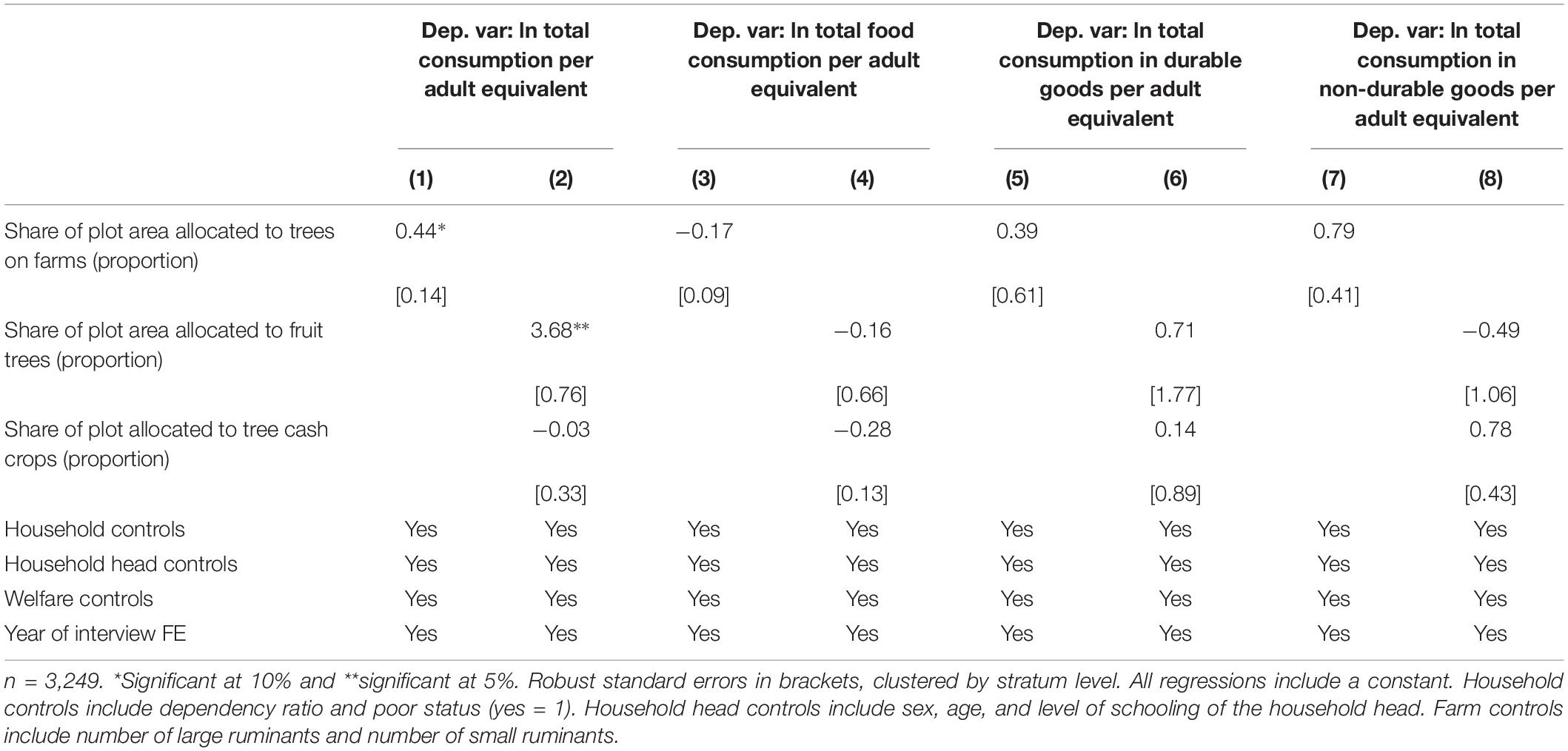
Table 4. Fixed-effects model results on household consumption and trees on farms adoption (excluding bananas as a fruit tree).
We observed a significant relationship between the share of farm area allocated to trees and total consumption per adult equivalent. An increase of 10% in tree area was associated with a 4.4% increase in consumption. That is, a household that moved from the 3% average share of land allocated to trees on farms to a 13% share was expected to see a total consumption increase of ∼4.4%. This increase was mainly due to the increase of fruit trees where the point estimates showed a significant and larger parameter. For example, a somewhat extreme case in which a household with an average of 0.1% of farm area allocated to fruit trees moved to a 10% allocation (a 10 standard deviation difference) correlated to a ∼30% increase in consumption. The presence of tree cash crops was not associated with a change in consumption. Overall, households that increased the area allocated to trees – in particular fruit trees – saw an increase in their total consumption per adult equivalent during the study period.
We replicated the same analysis as above including banana species within the classification of trees (Table 5). In contrast to results without bananas, the area allocated to any kind of tree was not a statistically significant predictor of total consumption per adult equivalent. However, we found a significant effect on the total consumption in non-durable goods (e.g., notably, food) per adult equivalent (Table 5: columns 7 and 8).
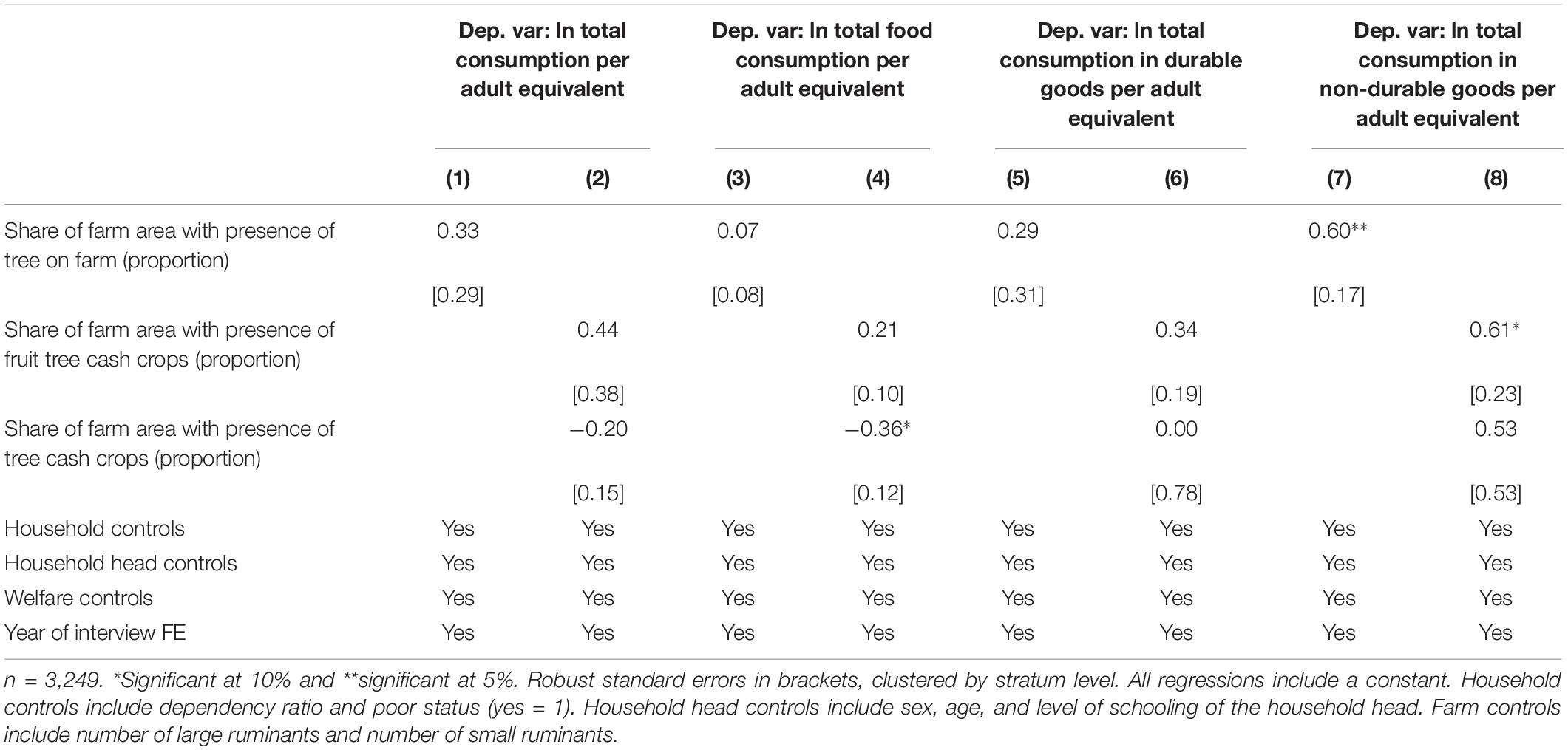
Table 5. Fixed-effects model results on household consumption and trees on farms adoption (including bananas as a fruit tree).
Trees on Farms and Child Nutrition
Table 6 reports the results for different nutritional outcomes for children aged 0–59 months in the 2013–2014 wave. As our main independent variable of interest, we included the share of gross agricultural income derived from trees on farms and fruit trees. We found significant associations between this variable and the probability of moderate wasting. That is, a one-unit increase in the proportion of the gross agricultural income coming from trees decreased the probability of children younger than 5 years experiencing moderate wasting by 3 percentage points. Our results did not show any associations between the share of gross agricultural income coming from trees on farms and the prevalence of moderate stunting or being moderately underweight.
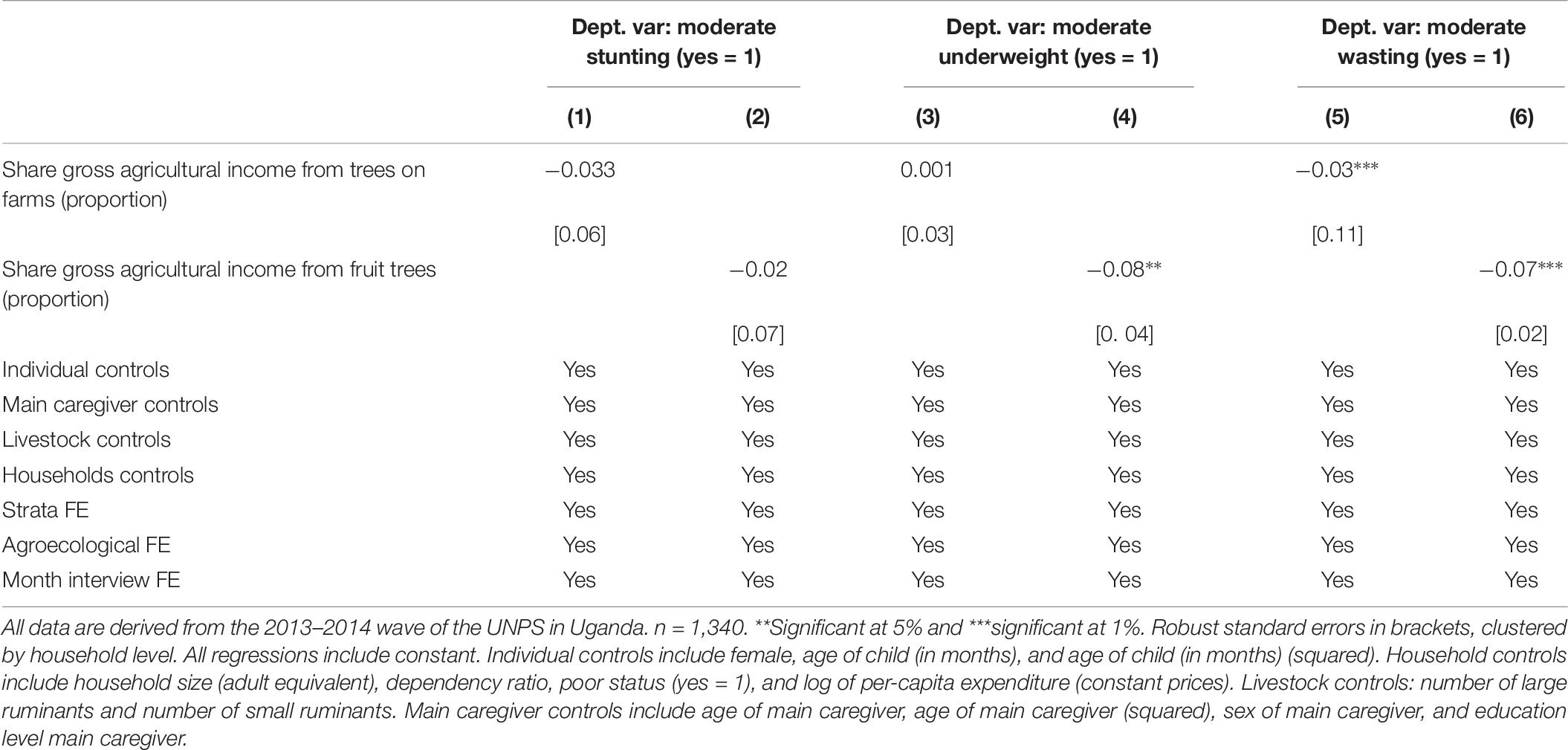
Table 6. Probit estimates for the relationship between health and nutrition status for children between 6 and 59 months old and the presence of trees on farms (marginal effects).
Looking at fruit trees only, we found similar results – with the probability of children younger than 5 years experiencing moderate wasting decreasing by 7 percentage points for a one-unit increase in the share of the gross agricultural income coming specifically from fruit trees on farms. The same pattern was observed for the prevalence of stunting: a one-unit increase in the share of gross agricultural income coming specifically from fruit trees on farms decreased the probability of experiencing stunting by 8 percentage points. Thus, the children living in households with a higher share of gross agricultural income from trees had less of a probability of being malnourished.
Discussion
Results from our analysis of nationally representative, household-level panel data from Uganda show that having trees on farms was associated with increased consumption rates and better nutritional status for children younger than 5 years – proxied by the prevalence of underweight and wasting. Fruit trees were particularly important in explaining this association: they were key for food and nutrition but also provided an important source of income for many households.
When we included bananas in our consumption analysis, we found significant results only for total household consumption of non-durable goods. This result makes sense given that the category of non-durable goods includes food, such as bananas. We had also expected that including bananas as a tree in our analysis would have been associated with greater total consumption per adult equivalent (as found in our main analysis), but it appears the key relationship is with consumption of non-durable goods, whereas fruit trees (other than bananas) were important to total consumption indicators. This finding may be due to the fact that such fruit not only can be consumed in the household but also can be more easily sold at market for income in addition to other potential ecosystem services provided by trees (e.g., to support agriculture through erosion control, pollination, etc.).
Our findings also suggest that trees on farms, especially fruit trees, might have helped address acute food shortages or illness, which are of relative short duration. The child health conditions of moderate stunting and being moderately underweight are associated with a short-term exposure to an inadequate calorie intake (World Health Organization and UNICEF, 2009). Fruit and other trees can provide a means to address this problem. Our results align with research from other parts of Africa that have found that forests and trees can act as “safety nets” for households as they are often able to produce food more reliably in the face of adverse weather conditions compared to annual crops, and they can help fill seasonal gaps in crop production (Kehlenbeck et al., 2013; Vira et al., 2015).
However, evidence on the specific relationship between trees on farms and dietary intake has remained limited (Powell et al., 2015). This is especially so for quantitative evidence that addresses the potential of reverse causality. The issue is that households with a more nutritionally adequate diet (and which are focused on keeping their children healthy) might choose to plant more fruit trees on their farms. An endogenous relationship between tree planting and consumption may also arise if households with higher income (and expenditures) have a higher ability to invest labor and money in on-farm tree planting. The household fixed-effects approach we use helps address this concern by capturing time-invariant household-level variables, including unobserved determinants of profits and permanent income and household ability to plant and manage trees.
We also caution that our results, while providing strong evidence on the association between trees on farms and changes in consumption of both food and non-food items, are not causal. Future work is needed to establish casual links between adoption of trees on farms and different livelihood outcomes such as those analyzed in this article. Inquiry along these lines will likely require data based on specific interventions examined using experimental or quasi-experimental approaches, which – with some exceptions (e.g., Coulibaly et al., 2017; Amadu et al., 2020; Hughes et al., 2020) – are still uncommon in the literature (Miller et al., 2020).
Another difficulty in quantifying the value of having trees on farms is that availability of a resource does not necessarily imply use. For example, the relationship between the availability of food (from trees on farms) and its consumption is often complex as households may use it for either (a) direct consumption, (b) sale that then in turn enables purchase of food, or (c) a combination of (a) and (b). In other words, having fruit trees on farms may lead to higher income, which then facilitates fruit purchases and fruit consumption. Simple surveys on the consumption of certain foods are thus not in themselves adequate for understanding the complex relations between trees on farms and diets (Dawson et al., 2014).
Relatedly, we note that our results may comprise a lower bound of the actual relationship between household well-being and trees on farms as many of the benefits of trees on farms are still unobservable, and our data are likely to be incomplete in terms of capturing all trees on farms (see section “Materials and Methods” above). For example, we are unable to estimate the indirect mechanisms through which trees on farms may operate to improve agricultural productivity (e.g., improved pollination of agricultural crops due to the presence of trees on farms). Such indirect pathways remain understudied, but available research suggests they may be important in many LMIC contexts (Baudron et al., 2017).
Conclusion
Trees on farms are often overlooked in development research and policy. This article demonstrates how national survey data can be used to shed light on the contribution on-farm trees can make to local livelihoods and food security. It represents the first study of which we are aware to use panel data over a relatively long time period (2005/2006–2013/2014) to examine the associations between having trees on farms and household well-being at the country scale.
Our approach to analyzing trees on farms at a national scale helps bolster understanding of the overall socioeconomic significance of such trees, including the non-timber products and environmental services they provide, among rural households in Uganda. Because we specifically focused on trees on farms (rather than those in forests), our analysis advances current, coarse regional or national-scale estimates linking (mainly) timber production figures to estimates of gross domestic product (FAO, 2014; Miller et al., 2017). However, future work is needed to examine other contexts to understand if similar patterns hold and why or why not. Results from this study also suggest that trees on farms should feature more prominently in debates and strategies for poverty reduction and sustainable development, more generally, in Uganda and beyond.
Data Availability Statement
All datasets generated for this study and relevant statistical code are available at: https://github.com/jcmunozmora/TreesOnFarm_Uganda.
Author Contributions
DM, JM-M, and AZ conceived and designed the study. JM-M organized the database. JM-M and LR performed the statistical analysis. JM-M prepared the first draft of the manuscript with DM, LR, and AZ writing sections of the manuscript. All authors contributed to manuscript revision and read and approved the submitted version.
Funding
This research was supported by the Program on Forests (PROFOR) at the World Bank and the USDA National Institute of Food and Agriculture, Hatch project #1009327. LR was funded by the European Research Council (ERC) under the European Union’s Horizon 2020 Research and Innovation Programme (Grant agreement No. 853222 FORESTDIET).
Conflict of Interest
The authors declare that the research was conducted in the absence of any commercial or financial relationships that could be construed as a potential conflict of interest.
Acknowledgments
We thank Sarah Brown, Karen Brooks, Luc Christiaensen, Peter Dewees, Frank Place, and the two reviewers for comments that have helped improve this article. Research assistance from Carly Hopkins is gratefully acknowledged.
Footnotes
- ^ Subsequently, forestry (Bakkegaard et al., 2016) and trees on farms modules (Miller et al., 2019) have been developed for national living standards and other surveys together with guidance on their use.
References
Amadu, F. O., Miller, D. C., and Mcnamara, P. E. (2020). Agroforestry as a pathway to agricultural yield impacts in climate-smart agriculture investments: evidence from southern Malawi. Ecol. Econ. 167:106443. doi: 10.1016/j.ecolecon.2019.106443
Angelsen, A., Jagger, P., Babigumira, R., Belcher, B., Hogarth, N. J., Bauch, S., et al. (2014). Environmental income and rural livelihoods: a global-comparative analysis. World Dev. 64, S12–S28.
Arvanitoyannis, I. S., and Mavromatis, A. (2009). Banana cultivars, cultivation practices, and physicochemical properties. Crit. Rev. Food Sci. Nutr. 49, 113–135. doi: 10.1080/10408390701764344
Azzarri, C., Zezza, A., Haile, B., and Cross, E. (2015). Does livestock ownership affect animal source foods consumption and child nutritional status? Evidence from Rural Uganda. J. Dev. Stud. 51, 1034–1059. doi: 10.1080/00220388.2015.1018905
Bacon, C. (2005). Confronting the coffee crisis: can fair trade, organic, and specialty coffees reduce small-scale farmer vulnerability in Northern Nicaragua? World Dev. 33, 497–511. doi: 10.1016/j.worlddev.2004.10.002
Bakkegaard, R. K., Agrawal, A., Animon, I., Hogarth, N., Miller, D., Persha, L., et al. (2016). National Socioeconomic Surveys in Forestry: Guidance and Survey Modules for Measuring the Multiple Roles of Forests in Household Welfare and Livelihoods. Rome: FAO.
Barrett, C. B., and Constas, M. A. (2014). Toward a theory of resilience for international development applications. Pnas 111, 14625–14630. doi: 10.1073/pnas.1320880111
Baudron, F., Duriaux Chavarría, J. Y., Remans, R., Yang, K., and Sunderland, T. (2017). Indirect contributions of forests to dietary diversity in Southern Ethiopia. Ecol. Soc. 22:28.
Beegle, K., De Weerdt, J., and Dercon, S. (2011). Migration and economic mobility in tanzania: evidence from a tracking survey. Rev. Econ. Stat. 93, 1010–1033. doi: 10.1162/rest_a_00105
Bhagwat, S. A., Willis, K. J., Birks, H. J. B., and Whittaker, R. J. (2008). Agroforestry: a refuge for tropical biodiversity? Trends Ecol. Evolut. 23, 261–267. doi: 10.1016/j.tree.2008.01.005
Cheng, S. H., Macleod, K., Ahlroth, S., Onder, S., Perge, E., Shyamsundar, P., et al. (2019). A systematic map of evidence on the contribution of forests to poverty alleviation. Environ. Evid. 8:3.
Coulibaly, J. Y., Chiputwa, B., Nakelse, T., and Kundhlande, G. (2017). Adoption of agroforestry and the impact on household food security among farmers in Malawi. Agric. Syst. 155, 52–69. doi: 10.1016/j.agsy.2017.03.017
Dawson, I. K., Leakey, R., Clement, C. R., Weber, J. C., Cornelius, J. P., Roshetko, J. M., et al. (2014). The management of tree genetic resources and the livelihoods of rural communities in the tropics: non-timber forest products, smallholder agroforestry practices and tree commodity crops. For. Ecol. Manag. 333, 9–21. doi: 10.1016/j.foreco.2014.01.021
Dewees, P. A. (2013). “Bouncing back: forests, trees and resilient households,” in Working Paper prepared for the International Conference on Forests for Food Security and Nutrition, Rome.
FAO. (2014). State of the World’s Forests. Enhancing the Socioeconomic Benefits from Forests. Rome: FAO, 133.
Ferris, S., Robbins, P., Best, R., Seville, D., Buxton, A., Shriver, J., et al. (2014). “Linking smallholder farmers to markets and the implications for extension and advisory services,” in Meas Discussion Paper 4, Washington, DC: USAID.
Franzel, S., Carsan, S., Lukuyu, B., Sinja, J., and Wambugu, C. (2014). Fodder trees for improving livestock productivity and smallholder livelihoods in Africa. Curr. Opin. Environ. Sust. 6, 98–103. doi: 10.1016/j.cosust.2013.11.008
Fulton, S. L., Mckinley, M. K., Young, I. S., Cardwell, C. R., and Woodside, J. V. (2016). The effect of increasing fruit and vegetable consumption on overall diet: a systematic review and meta-analysis. Crit. Rev. Food Sci. Nutr. 56, 802–816. doi: 10.1080/10408398.2012.727917
Garrity, D. P., Akinnifesi, F. K., Ajayi, O. C., Weldesemayat, S. G., Mowo, J. G., Kalinganire, A., et al. (2010). Evergreen Agriculture: a robust approach to sustainable food security in Africa. Food Secur. 2, 197–214. doi: 10.1007/s12571-010-0070-7
Gergel, S. E., Powell, B., Baudron, F., Wood, S. L., Rhemtulla, J. M., Kennedy, G., et al. (2020). Conceptual links between landscape diversity and diet diversity: a roadmap for transdisciplinary research. BioScience, 70, 563–575. doi: 10.1093/biosci/biaa048
Hall, J. N., Moore, S., Harper, S. B., and Lynch, J. W. (2009). Global variability in fruit and vegetable consumption. Am. J. Prevent. Med. 36, 402–409. doi: 10.1016/j.amepre.2009.01.029
Hughes, K., Morgan, S., Baylis, K., Oduol, J., Smith-Dumont, E., Vågen, T.-G., et al. (2020). Assessing the downstream socioeconomic impacts of agroforestry in Kenya. World Dev. 128:104835. doi: 10.1016/j.worlddev.2019.104835
Hulme, M. F., Vickery, J. A., Green, R. E., Phalan, B., Chamberlain, D. E., Pomeroy, D. E., et al. (2013). Conserving the birds of Uganda’s banana-coffee arc: land sparing and land sharing compared. PLoS One 8:e54597. doi: 10.1371/journal.pone.0054597
Ickowitz, A., Powell, B., Salim, M. A., and Sunderland, T. C. H. H. (2014). Dietary quality and tree cover in Africa. Glob. Environ. Change 24, 287–294. doi: 10.1016/j.gloenvcha.2013.12.001
Kareiva, P., Watts, S., Mcdonald, R., and Boucher, T. (2007). Domesticated nature: shaping landscapes and ecosystems for human welfare. Science 316, 1866–1869. doi: 10.1126/science.1140170
Kehlenbeck, K., Asaah, E., and Jamnadass, R. (2013). “Diversity of indigenous fruit trees and their contribution to nutrition and livelihoods in sub-Saharan Africa: examples from Kenya and Cameroon,” in Diversifying Food and Diets Using Agricultural Biodiversity to Improve Nutrition and Health, eds J. C. Fanzo, D. Hunter, T. Borelli, and F. Mattei (London: Earthscan).
Lasco, R. D., Delfino, R. J. P., Catacutan, D. C., Simelton, E. S., and Wilson, D. M. (2014). Climate risk adaptation by smallholder farmers: the roles of trees and agroforestry. Curr. Opin. Environ. Sust. 6, 83–88. doi: 10.1016/j.cosust.2013.11.013
Leakey, R. R., and Newton, A. C. (eds) (1994). Tropical Trees: the Potential for Domestication and the Rebuilding of Forest Resources, Vol. 29. Richmond: Hmso.
Mbow, C., Van Noordwijk, M., Luedeling, E., Neufeldt, H., Minang, P. A., and Kowero, G. (2014). Agroforestry solutions to address food security and climate change challenges in Africa. Cur. Opin. Environ. Sust. 6, 61–67. doi: 10.1016/j.cosust.2013.10.014
Meijer, S. S., Catacutan, D., Ajayi, O. C., Sileshi, G. W., and Nieuwenhuis, M. (2015). The role of knowledge, attitudes and perceptions in the uptake of agricultural and agroforestry innovations among smallholder farmers in sub-Saharan Africa. Int. J. Agric. Sust. 13, 40–54.
Miller, D., and Hajjar, R. (2020). Forests as pathways to prosperity: empirical insights and conceptual advances. World Dev. 125:104647. doi: 10.1016/j.worlddev.2019.104647
Miller, D. C., Muñoz-Mora, J. C., and Christiaensen, L. (2017). Prevalence, economic contribution, and determinants of trees on farms across Sub-Saharan Africa. For. Policy Econ. 84, 47–61. doi: 10.1016/j.forpol.2016.12.005
Miller, D. C., Munᚦoz-Mora, J. C., Zezza, A., and Durazo, J. (2019). Trees on Farms: Measuring Their Contribution to Household Welfare. A Guidebook for Designing Household Surveys. Washington, DC: World Bank.
Miller, D. C., Ordoñez, P. J., Brown, S. E., Forrest, S., Nava, N. J., Hughes, K., et al. (2020). The impacts of agroforestry on agricultural productivity, ecosystem services, and human well-being in low-and middle-income countries: an evidence and gap map. Campbell Syst. Rev. 16:e1066.
Muleta, D., Assefa, F., Nemomissa, S., and Granhall, U. (2011). Organic benefits of shade trees un coffee production systems in bonga and yayu-hurumi districtis southwestern Ethiopia: farmers’ perception. Ethiop. J. Educ. Sci. 7, 39–55.
Place, F., Garrity, D., Mohan, S., and Agostini, P. (2016). Tree-Based Production Systems for Africa’s Drylands. Washington, DC: World Bank.
Powell, B., Thilsted, S. H., Ickowitz, A., Termote, C., Sunderland, T., and Herforth, A. (2015). Improving diets with wild and cultivated biodiversity from across the landscape. Food Sec. 7, 535–554. pmid:nopmid. doi: 10.1007/s12571-015-0466-5
Reed, J., Van Vianen, J., Foli, S., Clendenning, J., Yang, K., Macdonald, M., et al. (2017). Trees for life: the ecosystem service contribution of trees to food production and livelihoods in the tropics. For. Policy Econ. 84, 62–71. doi: 10.1016/j.forpol.2017.01.012
Schreckenberg, K., Awono, A., Degrande, A., Mbosso, C., Ndoye, O., and Tchoundjeu, Z. (2006). Domesticating indigenous fruit trees as a contribution to poverty reduction. For. Trees Livelih. 16, 35–51. doi: 10.1080/14728028.2006.9752544
Scott, J. C. (1976). The Moral Economy of the Peasant: Rebellion and Subsistence in Southeast Asia. New Haven, CT: Yale University Press.
Swennen, R., and Vuylsteke, D. (1991). “Bananas in Africa: diversity, uses and prospects for improvement,” in Crop Genetic Resources of Africa, eds N. Q. Ng, P. Perrino, F. Attere, Zedah, N. Q. Ng, P. Perrino, et al. (Rome).
Vira, B., Wildburger, C., and Mansourian, S. (2015). Forests and food: Addressing Hunger and Nutrition Across Sustainable Landscapes. Cambridge: Open Book Publishers.
Waldron, A., Garrity, D., Malhi, Y., Girardin, C., Miller, D. C., and Seddon, N. (2017). Agroforestry can enhance food security while meeting other sustainable development goals. Trop. Conserv. Sci. 10:194008291772066. doi: 10.1177/1940082917720667
Willett, W., Rockström, J., Loken, B., Springmann, M., Lang, T., Vermeulen, S., et al. (2019). Food in the Anthropocene: the Eat–Lancet commission on healthy diets from sustainable food systems. Lancet 393, 447–492. doi: 10.1016/S0140-6736(18)31788-4
World Health Organization and UNICEF (2009). Who Child Growth Standards and the Identification of Severe Acute Malnutrition in Infants and Children : A Joint Statement. Washington, DC: United Nations Children’s Fund.
Keywords: agroforestry, food security, poverty, nutrition, sustainable livelihoods, Uganda
Citation: Miller DC, Muñoz-Mora JC, Rasmussen LV and Zezza A (2020) Do Trees on Farms Improve Household Well-Being? Evidence From National Panel Data in Uganda. Front. For. Glob. Change 3:101. doi: 10.3389/ffgc.2020.00101
Received: 16 February 2020; Accepted: 04 August 2020;
Published: 16 September 2020.
Edited by:
Terence C. Sunderland, The University of British Columbia, CanadaReviewed by:
Mani Nepal, International Centre for Integrated Mountain Development, NepalCharlie Shackleton, Rhodes University, South Africa
Copyright © 2020 Miller, Muñoz-Mora, Rasmussen and Zezza. This is an open-access article distributed under the terms of the Creative Commons Attribution License (CC BY). The use, distribution or reproduction in other forums is permitted, provided the original author(s) and the copyright owner(s) are credited and that the original publication in this journal is cited, in accordance with accepted academic practice. No use, distribution or reproduction is permitted which does not comply with these terms.
*Correspondence: Daniel C. Miller, dcmiller@illinois.edu
†These authors have contributed equally to this work
 Daniel C. Miller
Daniel C. Miller Juan Carlos Muñoz-Mora
Juan Carlos Muñoz-Mora Laura V. Rasmussen
Laura V. Rasmussen Alberto Zezza
Alberto Zezza